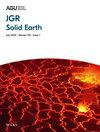Campi Flegrei动乱期间大地震的准备阶段(2020-2024年)
IF 4.1
2区 地球科学
Q1 GEOCHEMISTRY & GEOPHYSICS
引用次数: 0
摘要
Campi Flegrei持续不断的动乱给危害评估和风险缓解带来了重大挑战。自2020年以来,这个人口稠密的地区经历了2万多次浅层地震,这是由机械强度很强的盖层下的热液积聚造成的。在这项工作中,我们分析了表征持续危机的地震活动,还包括2024年5月发生的4.4级地震,该地震与RITE GPS站的火山口累计隆起130 cm相对应。通过对微震活动演化和变形趋势的联合解释,揭示了大地震的准备阶段。我们对2015年至2024年的20个地震序列的分析表明,对于较大的地震来说,这是一个一致的准备阶段,变形率、累积地震矩和地震震级之间存在很强的相关性。残余应变,代表变形驱动输入和地震输出之间的差异,成为与最大地震震级线性相关的关键参数。在人口稠密的Campi Flegrei地区揭示更大地震的准备阶段有可能大大有助于减轻地震风险。基于应变动力学的初步、简单的预测模型显示出有希望的结果,为开发提前几天预测地震震级和事件发生率的新方法开辟了道路。我们的见解为改善Campi Flegrei和全球其他火山系统的地震风险缓解策略提供了重要基础。本文章由计算机程序翻译,如有差异,请以英文原文为准。
Preparatory Phase of Major Earthquakes During Campi Flegrei Unrest (2020–2024)
The ongoing unrest at Campi Flegrei is posing significant challenges for hazard assessment and risk mitigation. This densely populated region has experienced more than 20,000 shallow earthquakes since 2020, driven by hydrothermal fluid accumulation beneath a mechanically strong caprock. In this work, we analyze the seismic activity characterizing the ongoing crisis, also including the magnitude Md 4.4 occurred in May 2024 in correspondence of a cumulative caldera uplift of 130 cm at the RITE GPS station. Here, we demonstrate that the joint interpretation of micro-seismicity evolution and deformation trend reveals the preparatory phase of major earthquakes. Our analysis of 20 seismic sequences from 2015 to 2024 highlights for larger earthquakes a consistent preparatory phase, with a strong correlation between deformation rates, cumulative seismic moment, and earthquake magnitudes. Residual strain, representing the difference between deformation-driven input and seismic output, emerges as a critical parameter linearly associated with the maximum earthquake magnitudes. Unveiling the preparation phase of larger earthquakes in the densely populated Campi Flegrei area has the potential to significantly contribute to seismic risk mitigation. Preliminary, simple predictive models based on strain dynamics show promising results, leading the way to developing novel approaches to forecast earthquake magnitudes and event rates days in advance. Our insights provide a crucial foundation for improving seismic risk mitigation strategies at Campi Flegrei and other volcanic systems worldwide.
求助全文
通过发布文献求助,成功后即可免费获取论文全文。
去求助
来源期刊

Journal of Geophysical Research: Solid Earth
Earth and Planetary Sciences-Geophysics
CiteScore
7.50
自引率
15.40%
发文量
559
期刊介绍:
The Journal of Geophysical Research: Solid Earth serves as the premier publication for the breadth of solid Earth geophysics including (in alphabetical order): electromagnetic methods; exploration geophysics; geodesy and gravity; geodynamics, rheology, and plate kinematics; geomagnetism and paleomagnetism; hydrogeophysics; Instruments, techniques, and models; solid Earth interactions with the cryosphere, atmosphere, oceans, and climate; marine geology and geophysics; natural and anthropogenic hazards; near surface geophysics; petrology, geochemistry, and mineralogy; planet Earth physics and chemistry; rock mechanics and deformation; seismology; tectonophysics; and volcanology.
JGR: Solid Earth has long distinguished itself as the venue for publication of Research Articles backed solidly by data and as well as presenting theoretical and numerical developments with broad applications. Research Articles published in JGR: Solid Earth have had long-term impacts in their fields.
JGR: Solid Earth provides a venue for special issues and special themes based on conferences, workshops, and community initiatives. JGR: Solid Earth also publishes Commentaries on research and emerging trends in the field; these are commissioned by the editors, and suggestion are welcome.
 求助内容:
求助内容: 应助结果提醒方式:
应助结果提醒方式:


